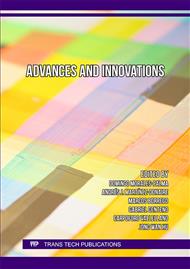[1]
Rao, M.G., P. Bharathi, and R. Akila, A comprehensive review on biopolymers. Sci. Revs. Chem. Commun. 4 (2014) 61-68.
Google Scholar
[2]
Chang, I., J. Im, and G.-C. Cho, Introduction of microbial biopolymers in soil treatment for future environmentally-friendly and sustainable geotechnical engineering, Sustainability. 8 (2016) 251.
DOI: 10.3390/su8030251
Google Scholar
[3]
Cheng, Y., et al., Polylactic acid (PLA) synthesis and modifications: a review, Frontiers of chemistry in China. 4 (2009) 259-264.
Google Scholar
[4]
Ncube, L.K., et al., Environmental impact of food packaging materials: A review of contemporary development from conventional plastics to polylactic acid based materials, Materials. 13 (2020) 4994.
DOI: 10.3390/ma13214994
Google Scholar
[5]
Martinez Villadiego, K., et al., Thermoplastic starch (TPS)/polylactic acid (PLA) blending methodologies: a review, Journal of Polymers and the Environment. 30 (2022) 75-91.
DOI: 10.1007/s10924-021-02207-1
Google Scholar
[6]
Jia, P., et al., Plasticizers derived from biomass resources: a short review. Polymers, 10 (2018) 1303.
Google Scholar
[7]
Tábi, T., T. Ageyeva, and J.G. Kovács, The influence of nucleating agents, plasticizers, and molding conditions on the properties of injection molded PLA products, Materials Today Communications. 32 (2022) 103936.
DOI: 10.1016/j.mtcomm.2022.103936
Google Scholar
[8]
Hassouna, F., et al., New approach on the development of plasticized polylactide (PLA): Grafting of poly (ethylene glycol) (PEG) via reactive extrusion, European Polymer Journal. 47 (2011) 2134-2144.
DOI: 10.1016/j.eurpolymj.2011.08.001
Google Scholar
[9]
Hassouna, F., et al., New development on plasticized poly (lactide): Chemical grafting of citrate on PLA by reactive extrusion, European Polymer Journal. 48 (2012) 404-415.
DOI: 10.1016/j.eurpolymj.2011.12.001
Google Scholar
[10]
Najafi, N., et al., Mechanical and morphological properties of injection molded linear and branched-polylactide (PLA) nanocomposite foams, European Polymer Journal. (2015) 73: 455-465.
DOI: 10.1016/j.eurpolymj.2015.11.003
Google Scholar
[11]
Feng, C., et al., Flame retardant properties and mechanism of an efficient intumescent flame retardant PLA composites, Polymers for Advanced Technologies. 27 (2016) 693-700.
DOI: 10.1002/pat.3743
Google Scholar
[12]
Godwin, A.D., Plasticizers, in Applied plastics engineering handbook. 1 (2017) 533-553.
Google Scholar
[13]
Rojas, A., et al., Active PLA packaging films: Effect of processing and the addition of natural antimicrobials and antioxidants on physical properties, release kinetics, and compostability, Antioxidants. 10 (2021) 1976.
DOI: 10.3390/antiox10121976
Google Scholar
[14]
Garcia-Garcia, D., et al., Improvement of PLA film ductility by plasticization with epoxidized karanja oil, Polymer Degradation and Stability. 179 (2020) 109259.
DOI: 10.1016/j.polymdegradstab.2020.109259
Google Scholar
[15]
Arrieta, M.P., et al., Development of flexible materials based on plasticized electrospun PLA–PHB blends: Structural, thermal, mechanical and disintegration properties, European Polymer Journal. 73 (2015) 433-446.
DOI: 10.1016/j.eurpolymj.2015.10.036
Google Scholar



